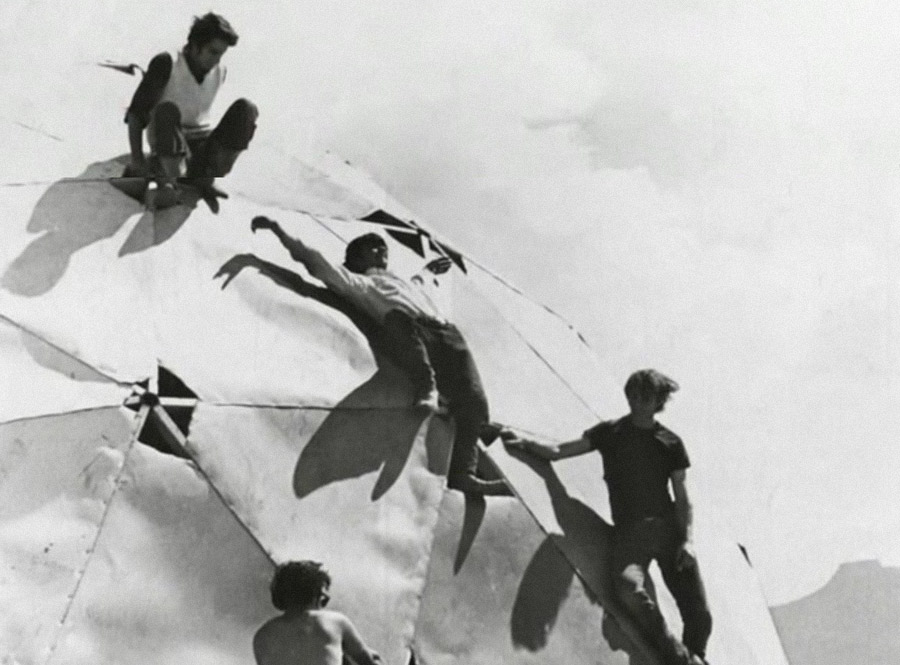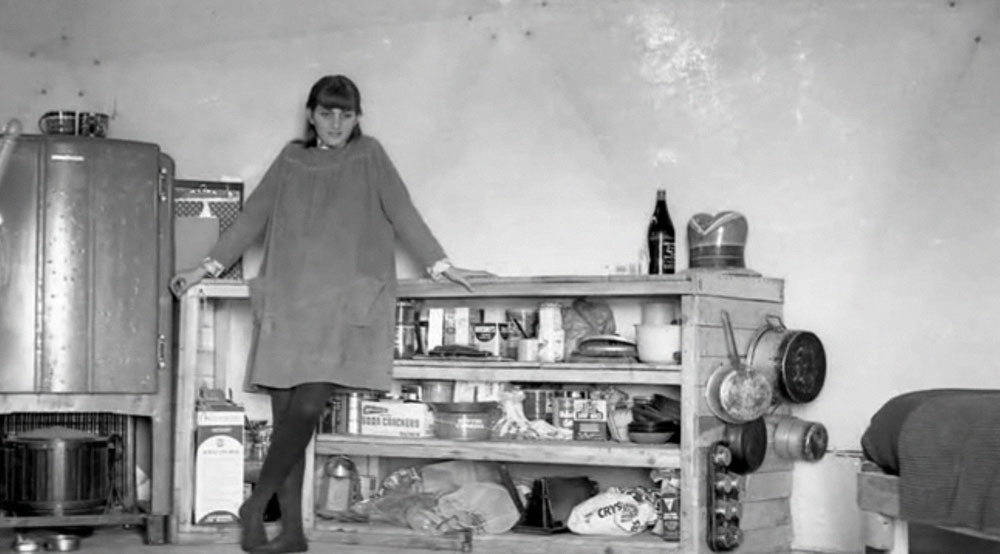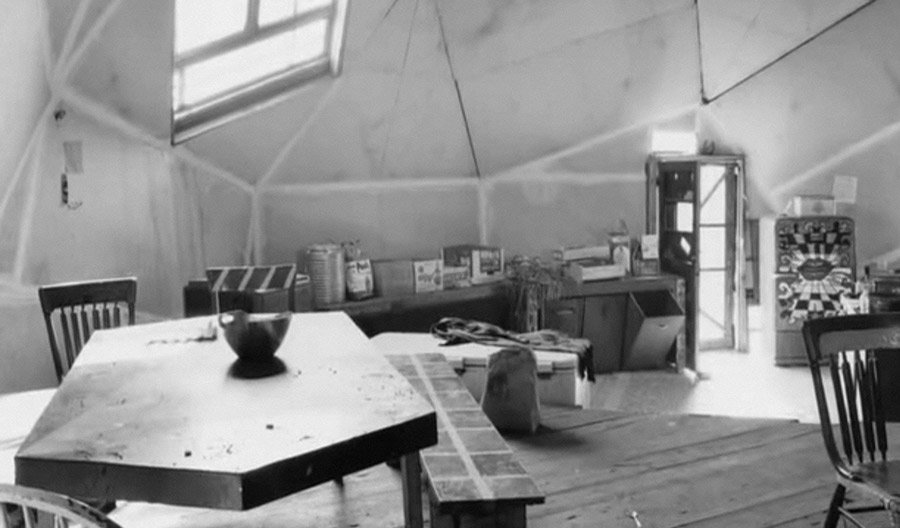-
Communities of
ConsciousnessFrom Drop City to the digital
By Fred Turner
Photo: Richard Kallweit
-






Contrary to popular belief, the New Communalists of the 1960s didn’t just drop out, they embraced technology in such a way as to influence the core attitude behind the biggest commune of all: the internet. But the reality was not as liberated and utopian as it seemed. Stanford professor and author Fred Turner relieves us of our rose-tinted spectacles.
In the summer of 1965, a ragtag handful of long-haired young men ambled into a Colorado junkyard with axes in their hands. One after another they climbed onto the tops of broken-down sedans and station wagons and began to hack away at their roofs. The junkyard owner charged them fifteen cents for each sheet of metal they managed to chop free. Every evening, they hauled their car tops home and cut them into panels, which they welded into what soon became a village of multi-coloured geodesic domes, perched on the open plains.
The village was called Drop City and it quickly became one of the most visible American communes of the 1960s. It also became a beacon to many who have designed our digital world. The Droppers, as they called themselves, were part of the largest wave of commune-building in American history. Between 1965 and 1973, historians estimate that as many as 600 communes were built across the United States and that 750,000 Americans took up communal living. These mostly young, white, middle class communards had extraordinary faith in technology, in themselves, and above all, in the power of design to replace conventional politics. Their example has long animated such leaders of California’s computing industry as Apple’s Steve Jobs and Google’s Larry Page and Sergey Brin. Yet, the communes of the 1960s were far from utopias. On the contrary: their failures should alert us to how badly misplaced our contemporary faith in design and in digital technology might be. -
“Kids, tear the top off your daddy's car...
-
»Properly arranged, the technologies of mainstream America could bring about utopia... a world in which each person could be connected to every other, without politics, in a state of perpetual fraternal intimacy.«
...and send it, together with 10 cents in cash or coin, to Drop City, Colorado.” (Photo: Clark Richert)
-
To understand why, we need to return to the America of the late 1960s. In popular accounts, the American hippies of the time marched against the Vietnam War during the day and dropped acid at night. Radical politics and alternative lifestyles were two sides of the same coin. In fact though, there were at least two distinct movements within the counterculture. The first, the New Left, did politics to change politics. Its members formed parties, organised committees, marched.
The second, which I will call the New Communalists, turned away from politics and toward consciousness as the engine of social change.
In his 1968 book The Making of a Counter Culture that first popularised the term “counterculture”, historian Theodore Roszak put the New Communalist vision thus: “building the good society is not primarily a social but a psychic task”. Like many who grew up in the shadow of the nuclear bomb, the New Communalists loathed large-scale technologies and the bureaucratic society that had built them. But they had also come of age alongside an unprecedented array of consumer technologies – inexpensive automobiles, portable radios, surfboards, electric guitars.












»On the actual communes of the 1960s, the turn away from government and toward technologies of consciousness rarely resulted in liberation.«
-
Rather than abandon these delights, the New Communalists declared them tools with which to alter their minds and so society as a whole.
Designers were to take up these products of industrial society and working with their hands, turn them into tools that could in turn support communities of consciousness. Properly arranged, the technologies of mainstream America could bring about utopia: to dance under psychedelic lights, with the howl of electric guitars circling through the air, offered many what they thought was a glimpse of a world in which each person could be connected to every other, without politics, in a state of perpetual fraternal intimacy.
Their founders dreamed that communities of consciousness would multiply, metastasise, and transform every corner of American life. Today, at least according to the leading makers of American digital technology, they have.
Though the communes of the 1960s almost all collapsed within a few years of their founding, executives at Apple and Google and Facebook, among many other firms, continue to promote computing in New Communalist terms. As Apple’s co-founder Steve Wozniak put it recently, “We created the computers to free the people up, give them instant communication anywhere in the world; any thought you had, you could share freely…[It] was going to overcome a lot of the government restrictions.”
Recent revelations of the American government’s digital surveillance programmes have revealed the depth of Wozniak’s naiveté. But the problem isn’t so much one of digital technology as one of our faith in design.
On the actual communes of the 1960s, the turn away from government and towards technologies of consciousness rarely resulted in liberation. On the contrary, it revivified the prejudices of mainstream America. In the late 1960s, many rural communards imagined that they were pioneers, setting out for unsettled lands.
Photo: Richard Kallweit
-

Extract from the “Drop City” documentary film directed by Joan Grossman, 2012. (Film © Seventh Art Releasing)
-
Fred Turner is an Associate Professor of Communication at Stanford University and the author of several books, including The Democratic Surround: Multimedia and American Liberalism from World War II to the Psychedelic Sixties (University of Chicago Press, 2013) and From Counterculture to Cyberculture: Stewart Brand, the Whole Earth Network and the Rise of Digital Utopianism (University of Chicago Press, 2006).
fredturner.stanford.edu
A slightly longer version of this article was first published in form magazine, issue 249, Sept/Oct 2013.



Stills from the documentary film "Drop City".
In fact, they often built their communes amongst Native American and Mexican-American communities that had been there for generations. Few New Communalists reached out to these groups. Rather, like the suburbanites they claimed to despise, many stayed within the bounds of their own carefully designed communities, among their own demographic kind. Likewise, when communes did away with the political process of rule-making and representative negotiation, they often re-empowered the most conventional forms of sexism. For all the talk of “free love” in the sixties, rural American communes tended to privilege heterosexuality and male sexual freedom.
This history offers us a warning. Seated behind our computer screens, on Facebook say, or some other social network, we are in touch with one another via invisible electronic signals and we seem to enjoy the sharing of consciousness promised by communal living. Much as the Droppers once repurposed the automobiles of American industry, we have transformed the computers of the military-industrial-academic establishment into tools for a kind of disembodied intimacy. But with whom are we intimate? Do we reach out to those with whom we most disagree? Do we travel across the boundaries of race and gender and nationality? And what kinds of communities do we build when we do?

-
Search
-
FIND PRODUCTS
PRODUCT GROUP
- Building Materials
- Building Panels
- Building technology
- Façade
- Fittings
- Heating, Cooling, Ventilation
- Interior
- Roof
- Sanitary facilities
MANUFACTURER
- 3A Composites
- Alape
- Armstrong
- Caparol
- Eternit
- FSB
- Gira
- Hagemeister
- JUNG
- Kaldewei
- Lamberts
- Leicht
- Solarlux
- Steininger Designers
- Stiebel Eltron
- Velux
- Warema
- Wilkhahn
-
Follow Us
Tumblr
New and existing Tumblr users can connect with uncube and share our visual diary.
»Architecture starts when you carefully put two bricks together. There it begins.«
Ludwig Mies van der Rohe
Keyboard Shortcuts
- Supermenu
- Skip Articles
- Turn Pages
- Contents


